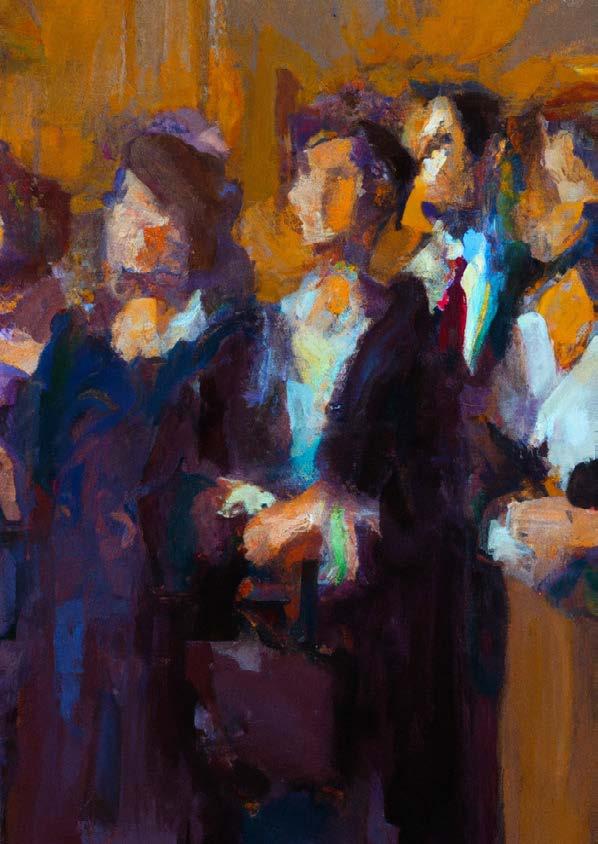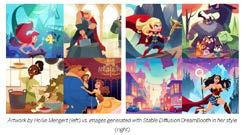
12 minute read
Exploring the Impact of Generative AI on Intellectual Property Law and the Future of Artistic Expres
Written by Thibaut D’Hulst & Geoffrey Schaefer
Intellectual Property law is a bedrock of our legal system, yet it is surprisingly squishy terra firma, being both concrete in its protections and wildly interpretative. This has become a major challenge in the age of Generative AI. IP law covers many mediums but it’s the painted work that presents the clearest example of this challenge, and one that we will return to throughout this article.
Advertisement
Consider a painter who is particularly inspired by the work of Jean Michel Basquiat and chooses to paint in a similar style. Over time, the artist becomes fairly competent and produces works that, while original, are increasingly representative of Basquiat’s own portfolio. It becomes difficult to distinguish between the two artists’ output. Is the inspired painter in violation of copyright law?
What if the artist is a Generative AI system? And the “inspiration” the AI took from Basquiat was it “seeing” the entirety of Basquiat’s portfolio as part of its training data? Like the case above, the outputs are “original” but clearly inspired by the paintings of Basquiat. Did the AI system violate copyright law? Does Basquiat’s estate have a case? We argue that in both cases the answer is “No.” In the former, the artist may be jeered and his work written off as “derivative,” but no serious lawyer would argue that a copyright violation had occurred. In the case of the Generative AI system, we argue that there are no factual or substantive differences; while the Generative AI system is a novel technology, its act of “creating” art is not.
This may seem like case closed. But this simulacrum of artistry presents much more challenging questions for society. What will it mean to live in a society whose predominant form of expression is synthetic, produced by the flipping of bits and not the human experience? And what role, if any, will IP law play with the growing use of Generative AI?

How Copyright Law Has Protected Artists Through Changes in Technology and Society
The history of copyright is closely connected with advances in technology and social norms. The invention of the printing press led to the first copyright law, Britain’s ‘Statute of Anne’. With this Statute, authors were given the exclusive right to authorize publications of their work. As technology advanced, new types of work qualified for copyright protection including sound recordings, audiovisual works (i.e., films), and eventually software. Of course, none of these existed when the Statute of Anne was enacted in 1710. Further technological inventions reduced the friction in the reproduction and disclosure of works, and in response to this “copyright,” evolved into a bundle of exclusive rights to include: (i) the right to reproduce the work; (ii) the right to distribute the work; (iii) the right to publicly perform or display the work; and (iv) the right to make derivative works.
To qualify for copyright protection, works must be creative (or “original”) and recorded in some form. But what do we mean by “originality”? In the E.U., the Court of Justice held that for a work to be original it must reflect the author’s “own individual character”(1). Under U.S. law, a work is original if it is “independently created by its author and possesses some minimal degree of creativity” (2). Moreover, most legal systems require the work to be recorded in a fixed form to benefit from copyright protection. That means that an abstract idea or general concept (such as the character in a story or the style of an artist) cannot be protected by copyright.
Generative AI programs that create text or images are very good at copying the style of an artist. This ability is not a new one; a skilled painter can produce a painting in the style of Basquiat and a trained musician can compose a song redolent of the Beatles. In most cases, the new works would not infringe on the copyright of the original artist. However, the risk of infringement increases the more elements it adds from the original work. For instance, if our Basquiat-inspired artist adds additional stylistic hallmarks from one or more of his specific paintings - such as his signature composition or colour palettes - then the new work is more likely to infringe the copyright of the original work. A recent lawsuit brought by Getty Images against the AI company, Stable Diffusion, followed exactly this reasoning. On the left is the original image (©Getty images) and on the right is an AI generated image which Getty claims to infringe its copyright.


Even if AI-generated images do not strictly reproduce the original work, they could be seen as “derivative works”. (Derivative is both a pejorative term used to describe an artist’s work and a technical legal category. Under copyright law, “derivative works” include translations, arrangements, or a transformation from an original work such as the adaptation of a book into a movie. Derivative works generally require the consent of the original author, unless they can rely on a copyright exception.)

In U.S. case law, a major exception exists for the “fair use” of copyright works, which is an important concept in our discussion of Generative AI. In 1994 the U.S. Supreme Court had to decide whether the song “Pretty Woman” by the popular rap ensemble, 2 Live Crew, infringed the copyright of Roy Orbison’s classic, “Oh, Pretty Woman”. The Supreme Court held that there was no infringement “in light of the song’s parodic purpose and character, its transformative elements, and considerations of the potential for market substitution”. The extent to which a new work is “transformative” became an important element in determining whether the new work can rely on the fair use exception. The Supreme Court pointed out that “the goal of copyright, to promote science and the arts, is generally furthered by the creation of transformative works. Such works thus lie at the heart of the fair use doctrine’s guarantee of breathing space within the confines of copyright”. This can be understood as an affirmation that art must be allowed to be “inspired” by existing art, whether it’s produced by a human or an algorithm.
(1) European Court of Justice. (2009). Infopaq International A/S v. Danske Dagblades Forening (Case C-5/08). Retrieved from https://eur-lex. europa.eu/legal-content/EN/TXT/HTML/?uri=CELEX:62008CJ0005&from=EN
(2) US Supreme Court in the case of Feist Publications, Inc. v. Rural Telephone Service Co., 499 U.S. 340 (1991)
Case Closed? Not Quite…
Generative AI brings new challenges to copyright law. Courts will deal with these challenges by developing the existing case law and applying or adapting the criteria that we discussed above. Yet the precise nature of why Generative AI challenges copyright presents much broader societal concerns that we are only now beginning to understand.
Weighing the value of granting exclusive IP rights with the different incentive structures from granting their exceptions is not always an obvious calculus. While copyright was developed to protect the livelihood of creative professionals, the exceptions were introduced to accommodate other important rights and interests. The protection of fair use may cover freedom of expression (in the case of parody), freedom of information (for critique or reporting on current events). And the protection of “transformative” works balances the rights of different authors and their contributions in furthering their own artistic endeavors. Indeed, art very often develops from other art. An overly broad interpretation of derivative works could therefore stifle important stimulants of creativity.
Similarly, exclusive IP rights must be weighed against the societal interest in incentivizing new research and development. As a specific example, a recent E.U. Directive “on copyright and related rights in the Digital Single Market” introduced an exception to allow the mining of online content to facilitate innovative research and analysis. These decisions are often highly context-dependent and can fluctuate with the details of the case at hand.
What Should We Protect in a World of Ubiquitous Production?
The history of IP law is at an inflection point. The principal question concerns how IP law should evolve to find a new and acceptable equilibrium between human creators and AI generators. We may find it necessary, if not desirable, to rethink the entire nature of what should be protected and why, and how AI systems themselves - as they become closer to autonomous agentsshould be considered in this legal paradigm.
We’re now seeing the first tangible symptoms of Generative AI’s disruption in the creative sector. Sci-fi magazine Clarkesworld no longer accepts submissions for publications after they were spammed by AI-generated stories. Copyright advocates warn that allowing copyright protections for AI-generated content could open the door for copyright trolls. For example, if a Generative AI published all possible arrangements in music, then any new hit single would immediately be hit by a copyright claim. While these trolling strategies are technically possible today, Generative AI makes them practically so by significantly reducing the friction of arranging, recording, and publishing music at scale. Each of these actions previously required copious time and expertise, but they can now be performed by the push of a button.
This disruption is likely to produce a new equilibrium that may have detrimental effects on creative industries. We have seen this before. Take the music industry as an exemplar. Beginning with peer-to-peer file sharing, music all of a sudden became widely available for free. Neither extant laws or the subsequent court cases could stop the ensuing infringement of copyright protections on a massive scale. But the industry eventually evolved its business model, providing musical content through either a monthly subscription or free with advertising.
Generative AI will only turbocharge similar transitions in other industries. Creativity is resilient by nature, but creative industries often suffer before they flourish.
New Roles for a New World
What role should the artist play in a world simultaneously understood, created, and influenced by Generative AI? Is there a difference between the creativity inherent in a human’s artistic expression and that of a machine? Will we care about the process behind a work of art, or simply its aesthetic beauty? One thing to consider is that Generative AI is now, at the very least, a source of creative output. Artists can choose to compete with these systems, or leverage them as tools in their own creative process. We emphasize the competitive dynamic here intentionally, as companies will increasingly use Generative AI systems to produce marketing copy, images, graphic design, and other artistic elements in the course of business. Whether prompted by a human or not, Generative AI systems are now creative actors in their own right and companies will use these systems when it makes creative and economic sense. This will force artists to either level-up their own work, or co-opt these systems to produce art that’s greater than the sum of their parts.
What role should the development teams behind these Generative AI systems play? Soon, the capabilities of these systems – largely due to their generalizability – will become untethered from the original intent they were imputed with. Development teams will have little control over what these systems are able to produce and how. As such, any “IP controls” deemed necessary and/or legally mandated will need to be built into a system during its initial design and training. Even still, this may not prevent, say, the production of a photographic image like in the Getty case described above.
Adobe offers another approach. They recently released a suite of tools for graphic designers and other artists to introduce Generative AI capabilities into their workflow, synthesizing the artist and the machine. This is a clear example of a development team using the power of these systems to aid artists instead of producing tools that could undermine their economic viability. Not all Generative AI systems can or should be built to serve artists and other producers of original work; but nor should they be neglected as stakeholders in the design and use of these systems.
Conclusion
The biggest question of all is what this means for society. The immense scale that Generative AI systems operate means that we’re nearing a scenario in which society’s collective artistic output will be produced by machines and not humans. In this scenario, the world that we know and engage with will be, by definition, artificial. The stories that we read, the paintings that we view, the movies that we consume will all be fragments of training data. Art will be new but familiar, original but fake. And the more that we engage with it, the more training data we’ll feed into the Generative AI systems and power their parrot-like production back to us. This may herald the end of artistry. Or it may spark a second Renaissance. Us humans are never content with stasis. We loathe sameness. A culture that’s sourced principally by Generative AI promises to produce just this, however, arresting the engines of our creativity. But artists abhor banality. A synthetic world is anathema to them. Creatives will forever be inflamed to create.
What role will IP law play in all of this? No meaningful role at all. Sure, there will be a slew of new court cases with novel but fundamentally similar arguments to one’s that have been made in every generation since the Statute of Anne. But the history of copyright law shows that the march of artistic progress continues untrammeled. In some ways, then, this is not a matter of law at all; this is simply us creatives raging against the machines.

At A Glance: Key Takeaways From This Article
• While Generative AI is a novel technology, its process of “seeing” and “producing” art is functionally the same as a human artist.
• IP law has always struggled to provide stringent protections for artists without stifling art itself. Generative AI is but the latest challenge to this equilibrium.
• The bigger societal question is what our world will look like when the predominant form of artistic expression is produced by the flipping of bits and not the human experience.










